The Story of Alice – the Secret History of Wonderland by Robert Douglas-Fairhurst and some other interesting things about Carroll from his letters and diaries
‘How do you know I’m mad?’ said Alice.
‘You must be," said the Cat, or you wouldn’t have come here.’
By Rose
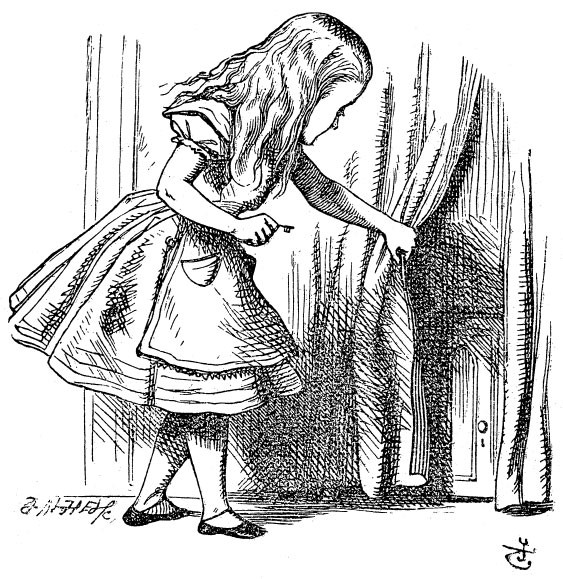 Along a riverbank the man rowed watching wild rabbit’s scramble across grasslands, birds soaring into skies. A little girl lounged next to him with her two sisters. She gazed at the man and spoke with a child’s insistence ‘you must tell me the rest of the story now’. She quietens only when he tells her about the Cheshire Cat, the Mad Hatter and the Pool of Tears, the Smoking Caterpillar and how everything changes into something else underground. Nothing, he tells her, is what it appears at first glance. The man with moody countenance and a distinct stutter is elated, the little girl, Alice, has helped him find a door back into his childhood: an escape to the magical tales and miniature worlds he constructed as a small boy. Carroll breathes life into a new world full of eccentric creatures, a surreal dream world where he took Alice on an unforgettable mesmeric fictional journey. Carroll would spend the rest of his life trying to reconstruct this summer, when his imagination fired with an intensity never to be repeated. A religious man, Carroll’s mind was overflowing with ideas; his interests a collection of symbolic logic, art, photography, fiction and invention. This is the story of the creation of Alice; of the original Alice, and all the other Alice’s that followed. The author brings to life the man that created a story that retains its power even now. Captivating and surreal, it’s a well-researched book and belongs on the shelf of anyone interested in the Alice in Wonderland books and the strange obsessional fascinating man who wrote them.
Along a riverbank the man rowed watching wild rabbit’s scramble across grasslands, birds soaring into skies. A little girl lounged next to him with her two sisters. She gazed at the man and spoke with a child’s insistence ‘you must tell me the rest of the story now’. She quietens only when he tells her about the Cheshire Cat, the Mad Hatter and the Pool of Tears, the Smoking Caterpillar and how everything changes into something else underground. Nothing, he tells her, is what it appears at first glance. The man with moody countenance and a distinct stutter is elated, the little girl, Alice, has helped him find a door back into his childhood: an escape to the magical tales and miniature worlds he constructed as a small boy. Carroll breathes life into a new world full of eccentric creatures, a surreal dream world where he took Alice on an unforgettable mesmeric fictional journey. Carroll would spend the rest of his life trying to reconstruct this summer, when his imagination fired with an intensity never to be repeated. A religious man, Carroll’s mind was overflowing with ideas; his interests a collection of symbolic logic, art, photography, fiction and invention. This is the story of the creation of Alice; of the original Alice, and all the other Alice’s that followed. The author brings to life the man that created a story that retains its power even now. Captivating and surreal, it’s a well-researched book and belongs on the shelf of anyone interested in the Alice in Wonderland books and the strange obsessional fascinating man who wrote them.
July 4, 1862 ‘I made an expedition up the river to Godstow with the three Liddells; we had tea on the bank there, and did not reach Christ Church till half-past eight. On which occasion I told them the fairy-tale of 'Alice's Adventures Underground,' 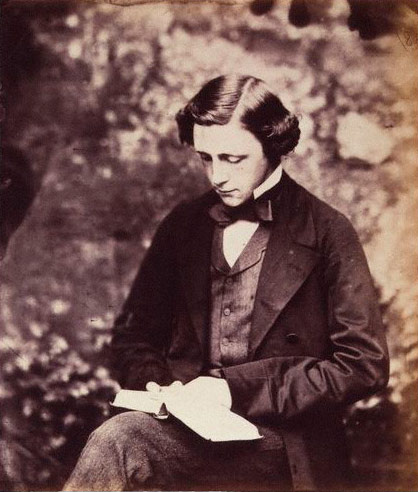 which I undertook to write out for Alice.’ Lewis Carroll in his diary
which I undertook to write out for Alice.’ Lewis Carroll in his diary
The author discusses the life of Carrol’s inspiration for Alice in Wonderland, Alice Liddell, and her life after Alice, how she married into wealth and became a lady of the manor with servants, raising three boys, two who were killed during the war. Alice lived a very luxurious life and didn’t achieve anything of great note in her later years apart from being a society wife and attending charity functions; however, she seemed to thrive in this life and was described as very comfortable in it. She came into the public’s attention when in her elderly years the family, for the first time, suffered financial losses and she sold her original manuscript of Carroll’s Alice in Wonderland given to her as a gift. This is at the time her son helped her visit America and this caused a great drama when the 'real' Alice as described by American's visited.
In The Story of Alice, Carroll’s life is investigated from childhood to his adult years in Christchurch; his teachings, interests and pastimes are clearly detailed and it’s obvious that rigorous research has been conducted for this book. Robert provides an excellent in-depth historical portrait of Carroll as a person that is a captivating read. 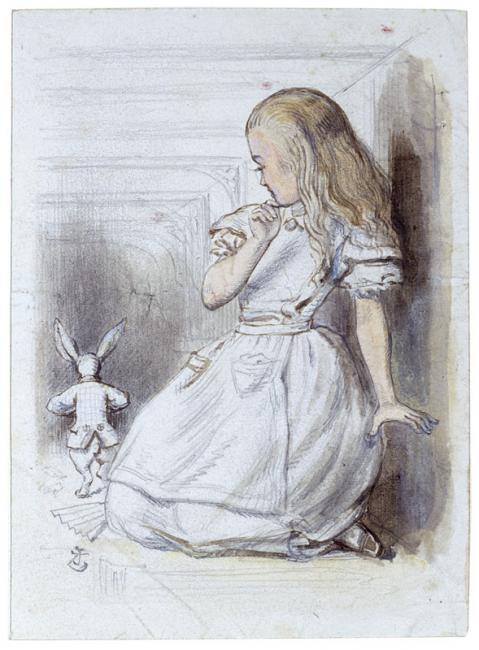 He provides descriptions of Carroll from other people who knew him so that a three dimensional image of the man comes to life on the page for the reader. The construction of Alice in Wonderland and through the Looking glass are examined, including the way that Carroll chose the titles of the books, and the influence of the book on people and other literature from the time. Eccentric, strange, a man with a deep fascination of everything around him, we begin to see the personality of the author who created wonderland and the pieces of the jigsaw come together, unravelling the mystery of the man, as his mind and life are explored. Carroll disliked attention from the media when he was alive, and didn’t like his address at Christchurch given out; he was, in many ways, a very secretive man, even some people that knew him and close family members would say that they didn’t know everything about him. He didn’t like being the focus of public attention, though he did enjoy the fact that his book would be found in the homes of children all over England, that Alice would enchant children the world over, this was something he took pleasure in. He took a great interest in how the book was marketed, and the drawings of Alice as well as merchadnise created at the time. He helped create a theatre production of Alice in wonderland at the time which starred the young actress Isa Bowman. In fact, Isa wrote a wonderful book about her time with Carroll after his death, which is a marvellous read.
He provides descriptions of Carroll from other people who knew him so that a three dimensional image of the man comes to life on the page for the reader. The construction of Alice in Wonderland and through the Looking glass are examined, including the way that Carroll chose the titles of the books, and the influence of the book on people and other literature from the time. Eccentric, strange, a man with a deep fascination of everything around him, we begin to see the personality of the author who created wonderland and the pieces of the jigsaw come together, unravelling the mystery of the man, as his mind and life are explored. Carroll disliked attention from the media when he was alive, and didn’t like his address at Christchurch given out; he was, in many ways, a very secretive man, even some people that knew him and close family members would say that they didn’t know everything about him. He didn’t like being the focus of public attention, though he did enjoy the fact that his book would be found in the homes of children all over England, that Alice would enchant children the world over, this was something he took pleasure in. He took a great interest in how the book was marketed, and the drawings of Alice as well as merchadnise created at the time. He helped create a theatre production of Alice in wonderland at the time which starred the young actress Isa Bowman. In fact, Isa wrote a wonderful book about her time with Carroll after his death, which is a marvellous read.
Here is a memory of Carroll from Isa.
'He was a little eccentric in his clothes. In the coldest weather he would never wear an overcoat, and he had a curious habit of always wearing, in all seasons of the year, a pair of grey and black cotton gloves.
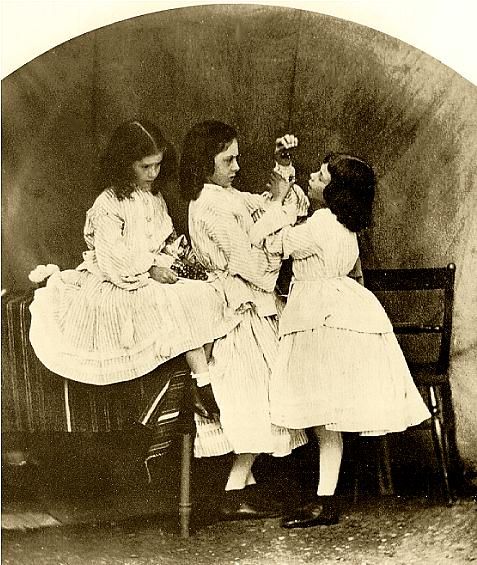 To understand Lewis Carol, to try to observe the world from his mind, even just a little, one has to understand his mind as a child. He was a little boy with a stutter who created fictional stories with a hunger, an almost thirst for fictional creations; he brought marionettes to life to act out his storytelling as a teenager with behind La Guida di Bragia, a burlesque written for his marionette theatre that was completely surreal and very reminiscent of his love for the absurd in Alice in Wonderland. He was fond of writing poems and little tales in tiny paper books, making things into miniature was something he treasured, he gave a miniature poetry book to his siblings calling his works ‘Useful and Instructive Poetry’ one poem called ‘The tale of the tail’ a sad story about a dog that is as bizarre as it is wonderful. He would continue this obsession with miniature as an adult, taking the Liddel sisters to his room to show them his micro-photographs. He would often have characters that changed size, not just in Alice but in other stories, making the big small was a creative idea that he was particularly fond of, Robert describes how Carroll used a Minimifying glass in his story Sylvie and Bruno to change the size of an elephant to a mouse, thus continuing throughout his life this miniature fascination. Even more telling he would sometimes write to child friends in miniature writing, he called fairy writing (Douglas-Fairhurst, 2016). One wonders if he ever wanted to make himself small again, and return to being a child.
To understand Lewis Carol, to try to observe the world from his mind, even just a little, one has to understand his mind as a child. He was a little boy with a stutter who created fictional stories with a hunger, an almost thirst for fictional creations; he brought marionettes to life to act out his storytelling as a teenager with behind La Guida di Bragia, a burlesque written for his marionette theatre that was completely surreal and very reminiscent of his love for the absurd in Alice in Wonderland. He was fond of writing poems and little tales in tiny paper books, making things into miniature was something he treasured, he gave a miniature poetry book to his siblings calling his works ‘Useful and Instructive Poetry’ one poem called ‘The tale of the tail’ a sad story about a dog that is as bizarre as it is wonderful. He would continue this obsession with miniature as an adult, taking the Liddel sisters to his room to show them his micro-photographs. He would often have characters that changed size, not just in Alice but in other stories, making the big small was a creative idea that he was particularly fond of, Robert describes how Carroll used a Minimifying glass in his story Sylvie and Bruno to change the size of an elephant to a mouse, thus continuing throughout his life this miniature fascination. Even more telling he would sometimes write to child friends in miniature writing, he called fairy writing (Douglas-Fairhurst, 2016). One wonders if he ever wanted to make himself small again, and return to being a child.
This was possibly one of the most pleasurable times of Carroll’s life, far away from adult responsibilities. As an adult he retained this passion for creating other lands, places and fictional characters. It was only through a meeting with a little inspirational little girl Alice Liddel, that his story concepts would create the book would influence modern culture in a way that few children’s stories ever had or would in history. Alice is everywhere in the world, making her presence known, the quirky Englishness of the book and English eccentricities made it popular in other countries, she is instantly identifiable as the girl lost in a surreal world, she is seen in art, films, words, pictures, imagery. Young people are inspired by Wonderland; they love to disappear into wonderland, just as I did as a little girl. Alice and wonderland will exist even far into the future as technology advances. This is the genius of Lewis Carroll and his mind. But the seeds of Alice were always alive inside him from a very young age.
Thus grew the tale of Wonderland:
Thus slowly, one by one,
Its quaint events were hammered out—
And now the tale is done,
And home we steer, a merry crew,
Beneath the setting sun.
Lewis Carroll
His ability to hold children spellbound with his stories is well documented in his early biography by his nephew Stuart Dodgson Collingwood, when he describes an event with Mrs Bennie, wife of the Rector of Glenfield who described a conversation with Carroll when she didn’t know his identity. She told her siblings that she’d met a ‘genius’ while holidaying in Whitby. Later, in the hotel she’d met this man, she looked for her twins and found both of them with Carroll; they were held captive by his miniature toys and story about sea-urchins and Ammonites. Mrs Bennie told him that he must be the author of ‘Alice in Wonderland’ which at first he amusingly denied, but later admitted (Collingwood, SD, 1898). He adored the vitality of children and the way that they could take an interest in everything around them from the very big to the very small, he was an intensely witty man who enjoyed spinning tales for children and watching their reactions. On one visit to a family he told a little boy that it would be better if he changed his head to a marble one, which it would be ideal as it would not need to be brushed or combed. He describes the boy’s relief, as he told his sister, ‘Do you hear that, Mary, it needn’t be combed if I have a marble head!’ Carroll was able to connect quickly with children, because of his unique humour and surreal way of looking at the world, creating fascinating absurdities and nonsense, illusion and fun everywhere he went.
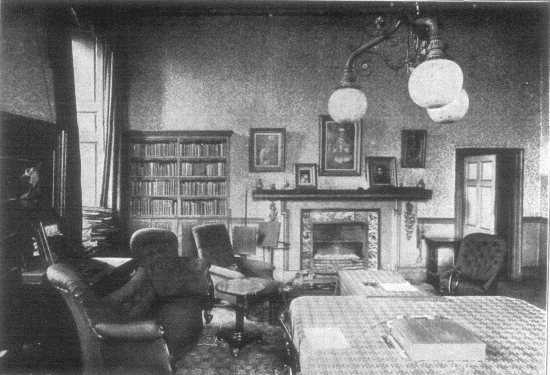 On the left is a photograph of Carroll's rooms in Christ Church. Another important aspect of Carroll’s life that isn’t as elaborated in the book, though his mathematical teachings and career are described, is the fact that I feel Carroll’s interest in Logic was a fundamental key to his personality, he seemed to see parts of the world around him through a mirror of mathematical logic. Understanding even the basics of symbolic logic allows one to enter his world, both fictionally and psychologically. Although logic might at first appear to be part of language or philosophy, it is in fact a branch of mathematics. Logic is a way of codifying a collection of items by application of strict rules. George Boole developed the foundation work for this branch of maths, but Lewis Carroll popularised the thinking and brought it to a larger audience. Modern day computer programmers will be familiar with many of the terms used by Carroll in his book ‘Symbolic Logic’ and its sister publication ‘The Game of Logic’. If one understands symbolic logic, one can try to unlock some of the mysteries of Carroll’s mind and the way he perceived the world. He would most likely be very analytical, very precise; his interpretation of written statements would be based on a very clear idea of what each word meant to the point where he might have appeared pedantic.
On the left is a photograph of Carroll's rooms in Christ Church. Another important aspect of Carroll’s life that isn’t as elaborated in the book, though his mathematical teachings and career are described, is the fact that I feel Carroll’s interest in Logic was a fundamental key to his personality, he seemed to see parts of the world around him through a mirror of mathematical logic. Understanding even the basics of symbolic logic allows one to enter his world, both fictionally and psychologically. Although logic might at first appear to be part of language or philosophy, it is in fact a branch of mathematics. Logic is a way of codifying a collection of items by application of strict rules. George Boole developed the foundation work for this branch of maths, but Lewis Carroll popularised the thinking and brought it to a larger audience. Modern day computer programmers will be familiar with many of the terms used by Carroll in his book ‘Symbolic Logic’ and its sister publication ‘The Game of Logic’. If one understands symbolic logic, one can try to unlock some of the mysteries of Carroll’s mind and the way he perceived the world. He would most likely be very analytical, very precise; his interpretation of written statements would be based on a very clear idea of what each word meant to the point where he might have appeared pedantic.
Logical thought is also required when making judgements if these judgements are to be fair and rational. Thus, as Carroll was a man of God, another deep part of his life and work, he may have seen God sitting in judgement of us; we trust that he is logical and not irrational because no one can know how to please an irrational God. There are some logical problems which deny the existence of God or at least create paradoxes with an omnipresent all powerful God, and so here we see how religion, legislation, mathematics, philosophy and common sense all are in the region of logic and would have influenced Carroll's view of the world. As a Reverend and a man of God, he had a belief at the end of his life all his good deeds would be mathematically added up and he would be judged, if you can understand Carroll’s complex personality this way, his devotion to God, his fascination with mathematical logic, then you understand the way the world and others looked to him and the way that both God and symbolic logic influenced his behaviour and belief system, as well as the effect of these subjects in his fiction writing.
Lewis created the Carroll Diagram and I’ve created an example below of it below, it is a way of logically organising sets of data that share attributes. The example below shows how shapes and colours can be organised. Beneath the figure are some predicate logic statements made about the example diagram. Carroll was indeed an exceptionally clever man in many ways. He wrote two books on mathematical logic which are very interesting and reveal a little of his personality, a witty, amusing man with a sense of fun in teaching.
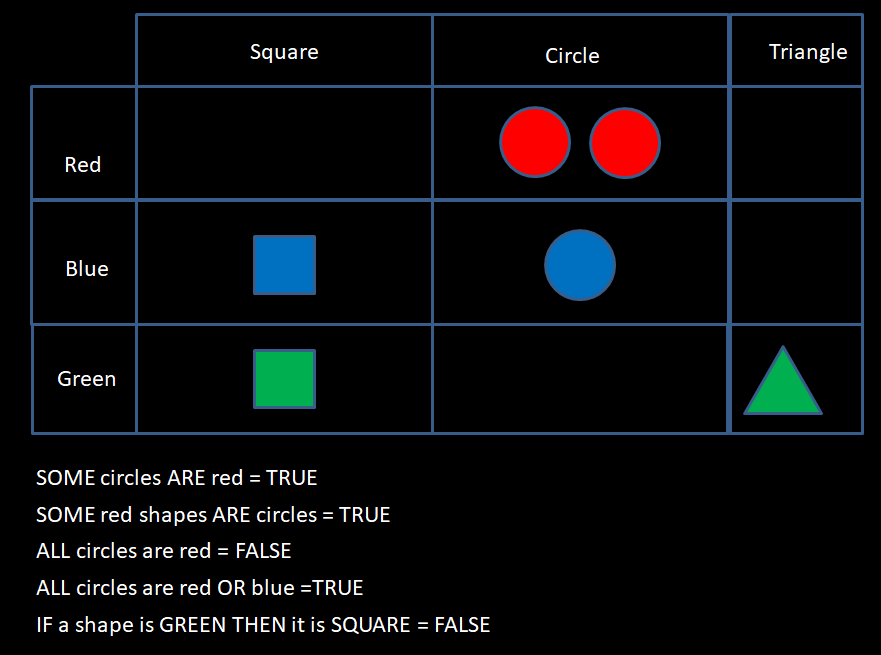
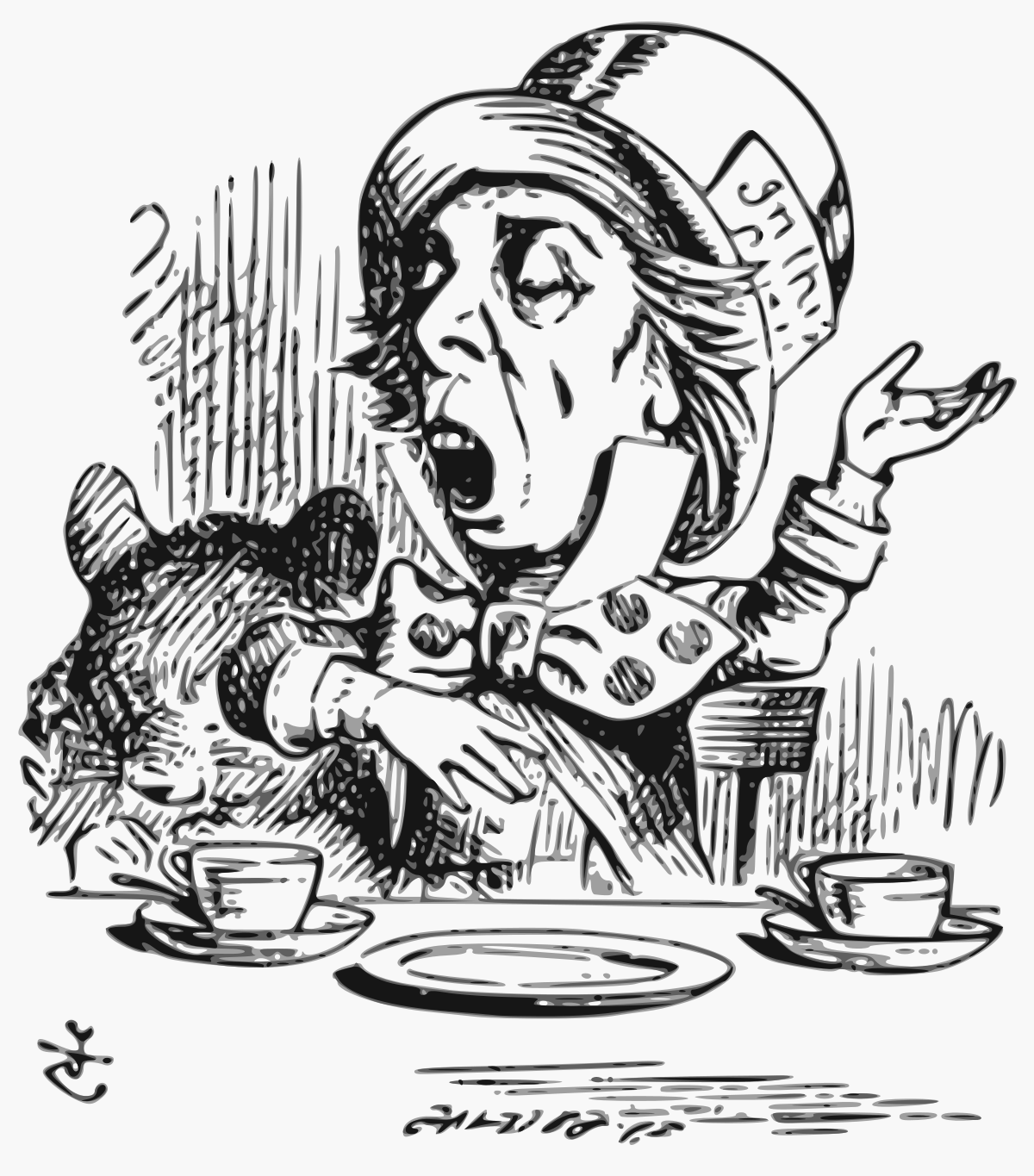 Taking symbolic logic as just one example, mathematical logic appears through many conversations in Alice in Wonderland. Mathematics is in fact a large theme in the book, and he brings in many of his obsessions into his tales. Even the Mad Hatter is actually very logical, although rather unnecessarily pedantic, this section of prose illustrates how common usage of English can sometimes contradict a strict logical analysis of our sentences, such that we don’t say precisely what we mean, yet usually people do understand what we mean.
Taking symbolic logic as just one example, mathematical logic appears through many conversations in Alice in Wonderland. Mathematics is in fact a large theme in the book, and he brings in many of his obsessions into his tales. Even the Mad Hatter is actually very logical, although rather unnecessarily pedantic, this section of prose illustrates how common usage of English can sometimes contradict a strict logical analysis of our sentences, such that we don’t say precisely what we mean, yet usually people do understand what we mean.
“Take some more tea,” the March Hare said to Alice, very earnestly. “I’ve had nothing yet,” Alice replied in an offended tone, “so I can’t take more.”
“You mean, you can’t take less,” said the Hatter: “it’s very easy to take more than nothing.”
For a more in-depth look at the mathematics in Alice in Wonderland, this is page provides some excellent examples The Hidden Math behind Alice in Wonderland’
Carroll was also an avid theatre goer, attending over one hundred and fifty performances in his lifetime at Christ Church. Robert describes many productions he attended and his avid interest in theatre, as well as the actresses and actors he made friends with at the time. This enables the reader with a very precise picture of how Carroll spent his time when he was not teaching, and gives a deep insight into his life. He was passionate about new engineering inventions and attended demonstrations of new discoveries. He also took an avid interest in occult phenomena and had many books on his shelves devoted to the subject. This would not be unusual at the time, as it was popularised in society in this era, however, Carroll was a Reverend and a man of God, and as such he was expected not to indulge in this kind of reading. I think one of the most important facets of Carroll, is his interest in many different subjects, inventions, engineering, art, drawing, occult, Symbolic Logic, theatre and theatre productions, he was open to so many things and ideas, this tells us a great deal about his fiction writing and how amazing it was, the world of Alice that he created, it is filled with magnificent ideas and complex themes and this I think is because Carroll was open to everything around him, his mind was as complex as the fictional worlds he created. He was the kind of man that anyone could have had a fascinating conversation with. The world to Carroll was full of adventurous creativity; he had an thirst for knowledge and life. He was very interested in art and artists, he adored musical boxes of ebony that played beautiful fairylike music with glass tops so that you could see hte mechanisms. For children, sometimes he would play all of them at once, the magic of the sound filling the air. Hhe had a deep mind that soaked up everything and created a magical haven in his room that must have been enchanting for those that visited him. If he existed now in modern times he would be fascinated with technology and computing, robotics, art and film; he’d have found all of it a wonder. It’s actually interesting to imagine Carroll in the present times and his reactions to the changing world around him, he was a man that understand the fast changing world he was living in, he would have been the kind of person that would have adapted to technologies, but I doubt he would have enjoyed the privacy he enjoyed at that period.
We spent an hour in the cathedral, which I will not attempt to describe further than by saying it was the most beautiful of all churches I have ever seen or can imagine. If one could imagine the spirit of devotion embodied in any material form, it would be in such a building. Lewis Carroll from his diary
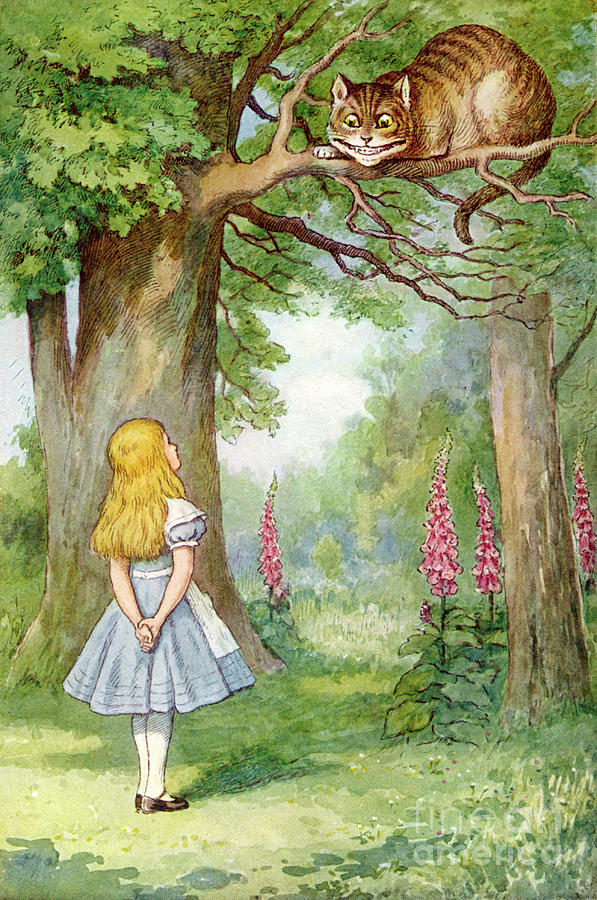 In fact, earlier in his life Carroll was deeply concerned that if he became a ministerial Reverend he would not be able to attend theatre of indulge in many of his hobbies, like photography and the occult art. However, because of his pronounced stutter it was considered an undesirable position for him, so he avoided the parochial clergy, as they followed strict rules of how they conducted their lives. In 1861 he was ordained by the Bishop of Oxford, however, although he gave some sermons, he didn’t continue to ‘priests orders’ of the time, it is said that this decision was due to both the strictness of the order, and also because someone with a serious speech impediment wouldn’t be able to fulfil his ministerial duties well (). Carroll had a very comfortable existence in Christ Church where he spent his entire life, he was in a very prestigious place and stayed there his whole life, there were great advantages for him to be living and teaching here.
In fact, earlier in his life Carroll was deeply concerned that if he became a ministerial Reverend he would not be able to attend theatre of indulge in many of his hobbies, like photography and the occult art. However, because of his pronounced stutter it was considered an undesirable position for him, so he avoided the parochial clergy, as they followed strict rules of how they conducted their lives. In 1861 he was ordained by the Bishop of Oxford, however, although he gave some sermons, he didn’t continue to ‘priests orders’ of the time, it is said that this decision was due to both the strictness of the order, and also because someone with a serious speech impediment wouldn’t be able to fulfil his ministerial duties well (). Carroll had a very comfortable existence in Christ Church where he spent his entire life, he was in a very prestigious place and stayed there his whole life, there were great advantages for him to be living and teaching here.
Carroll could be obsessional and exact in his routines and become stressed if he did not have his routine down to the letter, sometimes punishing himself by forcing himself to stand for hours at a desk, if he’d not completed his tasks the way he should have. Robert makes the astute observation that Carroll may have had a mild case of Obsessional Compulsive Disorder (Douglas-Fairhurst, R, 2016). Certainly, after reading the book you understand that there was something most strange about Carroll, and it wasn’t just his wonderfully bizarre characters in Alice in Wonderland that he created. He was an unusual man, even strange man, and he lived his life in a most odd way at times, he was very unconventional. He could be very obsessive, he was a man that spent the rest of his life after creating Alice in Wonderland trying to create a child friendship like the one he had with Alice Liddell for the rest of his life, having child friends to tell his stories too was one of his greatest joys. It must also be said that he struggled in the world of adults and in social situations with adults due to his stutter, which seemed to some adults see him as a poor social companion, and make negative comments, such as he was too boring or so shy that it was not pleasurable talking to him.
The effect of this stutter would have steered him away from large social groups. Recent research has revealed that many adults who stutter can suffer from problems with emotional functioning and social functioning can also be affected (Craig, Blumgart, Tran, 2009). This I feel is also one of the significant keys to understanding Carroll and analysing evidence presented about his unusual behaviours; some people with a stutter may avoid certain situations that cause anxiety, it can also create problems in the way they interact with the world, through no fault of their own.
Isa Bowman describes his stutter like this.
'He was afflicted with what I believe is known as “Housemaid’s knee,” and this made his movements singularly jerky and abrupt. Then again he found it impossible to avoid stammering in his speech. He would, when engaged in an animated conversation with a friend, talk quickly and well for a few minutes, and then suddenly and without any very apparent cause would begin to stutter so much, that it was often difficult to understand him. He was very conscious of this impediment, and he tried hard to cure himself.'
There is no doubt that Carroll will have been deeply affected by his stutter and Isa lets us know that the tried very much to cure himself, and that his stutter did control some of his behaviour and decision making. At that time little was known about stuttering and there were limited treatments available to Carroll. Carroll was very controlled about what he attended and who he spent his time with, that control was almost certainly governed by his social shyness and stutter. One can only imagine how this affected Carroll. He may even had symptoms of social phobia, but it would be impossible to make a diagnosis of either OCD or Social Phobia without the right tests, one can only theorise, certainly he was described as painfully shy, some people with severe stutters can develop a fear of social situations or develop avoidence techniques. It can be said that when thinking about children, they may be less judgemental at times, depending on their age, even if they can be more outspoken than adults. If a person like Carroll who had a gift of storytelling, could weave wonderful tales that create excitement in a child, the children may be willing to ignore a speech impediment in the way that an adult would not. Some adults who value social circles and status may have little patience for a man like Carroll. Have little patience for those that are 'different' or have a disability, and Carroll was very different to others. Of course, one cannot generalise and must be careful not to state that all people who stutter have the same problems as Carroll. But Carroll struggled in the adult world and in adult social circles.
One of Carroll’s favourite pastimes was photography; in 1856 he visited one of London’s most prestigious camera shops and purchased a camera for £15 pounds, which in those days would have been expensive (Douglas-Fairhurst, 2016). Creating photographs was a time consuming process and required careful consideration and knowledge of timing, chemicals and how to use them and extensive preparation. For someone as precise as Carroll with his attention to detail the hobby fitted someone who would view parts of the world through a mirror of mathematical logic. It soon became a way for him to capture the world around him, to capture a person, to feel as if he had preserved a child and a moment of joy, though this in itself was a misconception, he undoubtedly enjoyed believing that he could capture a person forever in a photograph. Photograpy was also a great medium for creating art pieces.
During his lifetime he took many photographs, some of crumbling cathedrals at Christ Church, others families and many of children, especially girls. It’s important to note that Carroll wasn’t the only person at this time drawn to using children as models in his photographs; there were others who saw children, especially girls as the perfect depiction of beauty and innocence, of fairylike creatures and sweet angels, slumbering on seats and in gardens with lost expressions, or praying. Carroll was a very accomplished photographer and took many striking photographs. He once told the parents of girls that he never took pictures of people over seventeen, but would take them at seventy years of age (Dodgson, S, 1898). He did take photographs of Alice Liddell and her sisters, at the time he told them the tale of Alice in Wonderland along the river. It is also true that one of the reasons Carroll probably liked photography, and Robert specifically comments on this in his book, was that it was a way of altering time, or stopping time, to keep a place or child in that exact moment forever; in those days photography would have seemed quite magical, a way of stopping the future and documenting the now. He could preserve moments, or at least feel that he had, a camera cannot record the personality or the essence of a child. It could only capture the physical and perhaps you could ascertain the mood of a child, with many photographs of Alice you can probably discern that she was confident, looking directly at the camera and sometimes looks insolent, some very brief sketches of a personality but not with any real depth. But for Carroll the camera was an object of power. Robert mentions an article Carroll wrote that children could be happy in moments in a way that a reflecting adult, who was always longing, could not. The camera also had the power of illusion and art, it could create great art and you could change the scene in the dark room and create illusions. Carroll was influenced by romantic painters of the time, and he was definitely trying to re-create such images with the camera.
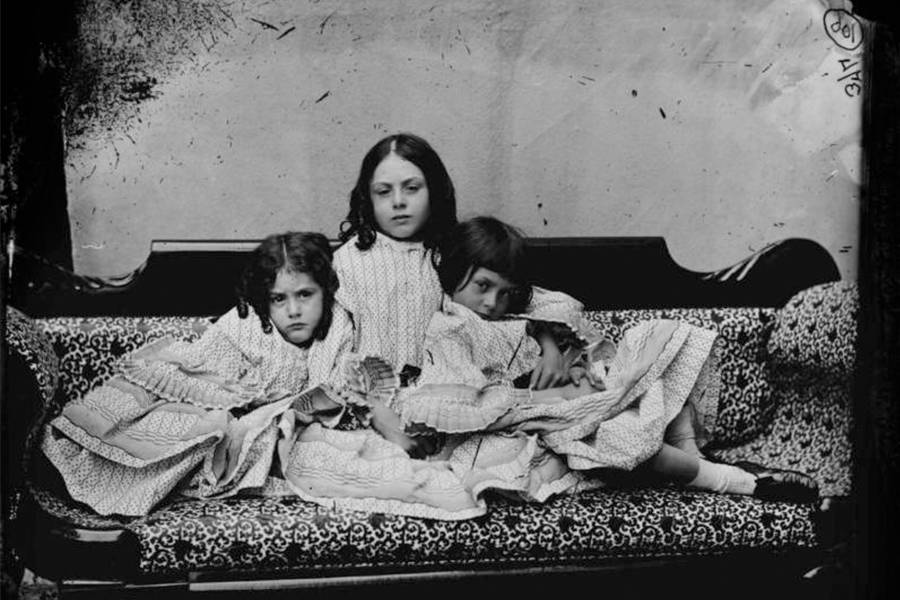 He photographed Alice pretending to sleep and in sleeping beauty, showing children and girls asleep was popular in art at the time as it was connected with death, so it’s obvious he was influenced by art that was popular in his day. It was also usual for romantic painters to show pretty children and young women in particular over-romantic settings and with idealised view of what they expected a female to be. They were often depicted as pure and innocent, sleeping maidens, dreamy maidens and exceptionally beautiful. This perspective was from the male gaze, as in Carroll’s time, almost all these painters were men; they often presented girls as pretty beggars, sleeping beauties, fairies, angels and characters from romantic poetry at the time. Carroll was definitely drawn to this romanticised view of the child and young woman and used it in his own compositions.
He photographed Alice pretending to sleep and in sleeping beauty, showing children and girls asleep was popular in art at the time as it was connected with death, so it’s obvious he was influenced by art that was popular in his day. It was also usual for romantic painters to show pretty children and young women in particular over-romantic settings and with idealised view of what they expected a female to be. They were often depicted as pure and innocent, sleeping maidens, dreamy maidens and exceptionally beautiful. This perspective was from the male gaze, as in Carroll’s time, almost all these painters were men; they often presented girls as pretty beggars, sleeping beauties, fairies, angels and characters from romantic poetry at the time. Carroll was definitely drawn to this romanticised view of the child and young woman and used it in his own compositions.
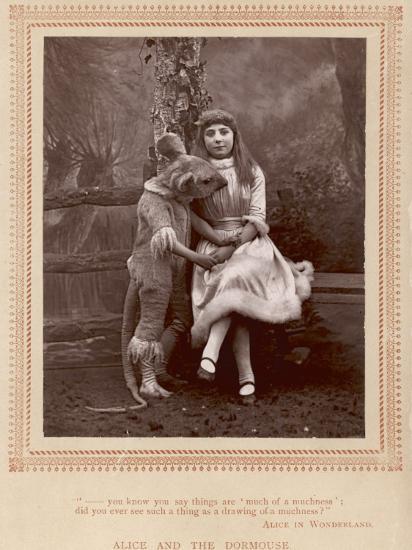 However, his photographs of girls and some letters to them would later arise would cause a serious problem in how he was perceived by others, with some citing an unhealthy interest in underage girls. It’s important to note that this has to be viewed in the historical time that Carroll lived. Women were viewed in a particular light at this time by men and older women were often seen as mere ‘marriage material’ not deserving of a proper education or profession, unless it was something like ‘painting flowers’. Even Carroll held some very chauvinistic views about educating females at the time, possibly influenced by his family and society at large, at Christ Church he was surrounded by male teachers in a very male establishment.
However, his photographs of girls and some letters to them would later arise would cause a serious problem in how he was perceived by others, with some citing an unhealthy interest in underage girls. It’s important to note that this has to be viewed in the historical time that Carroll lived. Women were viewed in a particular light at this time by men and older women were often seen as mere ‘marriage material’ not deserving of a proper education or profession, unless it was something like ‘painting flowers’. Even Carroll held some very chauvinistic views about educating females at the time, possibly influenced by his family and society at large, at Christ Church he was surrounded by male teachers in a very male establishment.
Nevertheless, it’s true that Carroll took some photographs of naked children, though the majority were dressed, he also wrote letters to some girls and used language like ‘My Darling’ and ‘I’ve kissed your hair’. When one looks at this evidence which is discussed in the book, you can understand the controversy this has caused and the view of Carroll has changed through time. It’s obvious that when inspired by Alice Liddell he felt some kind of ‘love’ for her.
However, you can also see a real immaturity and serious naivety in the way he speaks in the letters to other girls, an almost immature way of talking for an adult male of his age. One might even consider them as letters from a romantic ten year old boy. Although he has been described by some as a ‘repressed paedophile’ I would prefer to take the author of this books perspective, that it wasn’t like this. Vanessa Tait, the great-granddaughter of Alice Liddell, the inspiration for Carroll’s fictional version of Alice, stated that it would be wrong to white wash Carroll: that 'My understanding is that he was in love with Alice, but he was so repressed that he never would have transgressed any boundaries,' she said. 'I do think he was a strange man, and people who say he wasn’t and are totally whitewashing him are wrong. He was a strange man but an admirable one and I don’t want to tar him with accusations of paedophilia which we’re all so obsessed with now.’
I think ending this with a description from Isa Bowman, pictured in the photo above, who describes Carroll after his death.
'He was so good and sweet, so tender and kind, so certain that there was another and more beautiful life waiting for us, that I know, even as if I heard him telling it to me, that some time I shall meet him once more.' Isa Bowman
'The personal characteristic that you would notice most on meeting Lewis Carroll was his extreme shyness. With children, of course, he was not nearly so reserved, but in the society of people of maturer age he was almost old-maidishly prim in his manner. When he knew a child well this reserve would vanish completely, but it needed only a slightly disconcerting incident to bring the cloak of shyness about him once more, and close the lips that just before had been talking so delightfully.' Isa Bowman
In this descripiton Isa brings our attention to the way he found it much easier to talk to children than adults, due to his stutter. She also describes his nerves once the novels became famous and how he would decieve people into thinking that Dodgson and Carroll were two completely different people.
I would recommend the story of Alice by Robert Douglas-Fairhurst as a very in-depth look into Carroll's life and his mind as well as understanding the creation of Alice in wonderland and Through the Looking Glass, possibly one of the most valid historical accounts of the life of Lewis Carroll available. I would also recommend reading ‘The life and Letters of Lewis Carroll’ by his nephew, nephew Stuart Dodgson Collingwood, though written by a family member after Carroll’s death, it may be considered a biased in the presentation of Carroll, it still contains many interesting facts about his life and mind and has many extracts from his diary which are absorbing.
References
The Life and Letters of Lewis Carroll (Rev. C. L. Dodgson)
The Story of Alice – Lewis Carroll and The Secret History of wonderland Robert Douglas- Fairhurst
Symbolic Logic Lewis Carroll
The Game of Logic Lewis Carroll
The Impact of Stuttering on the quality of life in adults who stutter (Craig, Blumgart, Tran, 2009)